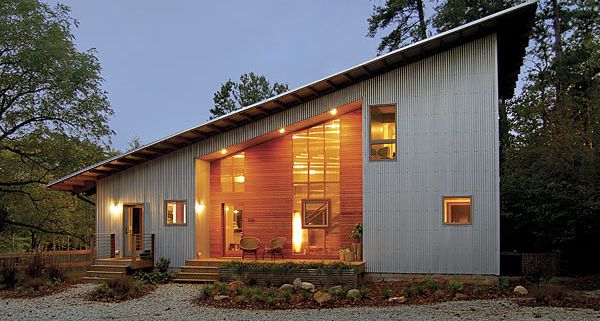Why Modular?
An affordable, custom home combines modular units with on-site construction, shedding light on the strengths and weaknesses of factory-built homes.

Synopsis: With their cookie-cutter approach to construction and limited options for windows, cabinets, and millwork, modular homes rarely illustrate thoughtful design and careful craftsmanship. But associate editor Chris Ermides writes about a “hybrid” house that combines the best features of modular construction — such as less waste, less exposure to the elements, and better control over costs — with on-site construction. This house, in Durham, N.C., is one example of an effort by custom-home builders to capitalize on the modular model without sacrificing design and construction integrity. It was built from three modules delivered by truck and stitched together on site with a roof and two walls.
It isn’t often that the term modular is used to describe a custom-built home. And why would it? Modular homes are designed from stock plans and made of factory-built modules finished with limited options for windows, cabinets, and millwork. What’s more, they rarely illustrate the mindful design and impeccable craftsmanship found in custom homes. The point is that most modular-built homes aren’t custom anything.
Cookie-cutter drawbacks aside, modular construction does have some benefits worth paying attention to. For example, there’s less waste because offcuts from one module end up as part of another project. And the house never sees a drop of rain until it’s weatherproof and finished. For these reasons and more, custom-home builders like Randy Lanou and his design/build firm BuildSense (www.buildsense.com) are finding ways to capitalize on the modular-built model without sacrificing design and construction integrity. Lanou calls the result a “hybrid” house: part modular, part site-built. This project in Durham, N.C., is a great example of how the two can come together in a way that benefits the builder and the homeowner.
Design starts with the limitations
House modules need to be transported via highway. Highway regulations in eastern North Carolina limit a module’s size to 13 ft. 9 in. in width and 15 ft. 9 in. in height, a size, Lanou says, that can work for bedrooms, kitchens, and bathrooms, but not for large spaces with tall ceilings. Clients Scott and Vikki Metheny went to BuildSense looking for a custom home that was affordable, efficient, and modern. (Scott, a skilled carpenter, later joined Lanou’s crew and became the contractor on record.) They wanted a large living room, a master suite, two additional bedrooms, ample daylight, and easy outdoor access.
Achieving these goals would be a challenge. With size restrictions in mind, Lanou used three modules, each for a separate part of the home. Kitchen, dining, half-bath, and laundry made up one module; the master suite and office alcove made up another. Two bedrooms and a full bath comprised the third. Lanou arranged the modules and stitched them together with a floor and roof to give the Methenys the large living room they were looking for.
Customizing can be a challenge
Modular manufacturers rely on Henry Ford’s assembly-line model for their success. Each module moves down a line where stations are set up for specific parts of the process. Unlike custom homes, though, the modules moving along the line don’t vary much from one another in terms of design. It’s all about efficiency of labor and materials.
The rub in all of this is that most modular companies are adamant about working with their own plans drawn by their own team of draftspersons. Interrupting the staff designers’ normal workflow can create problems. For BuildSense and the Methenys, this meant there were some discrepancies between the original drawings and the ones created at the factory. Before anything was approved, both builder and client reviewed each draft and made appropriate changes.
For more photos, drawings, and details, click the View PDF button below:
Fine Homebuilding Recommended Products
Fine Homebuilding receives a commission for items purchased through links on this site, including Amazon Associates and other affiliate advertising programs.

Smart String Line

Original Speed Square

100-ft. Tape Measure
























